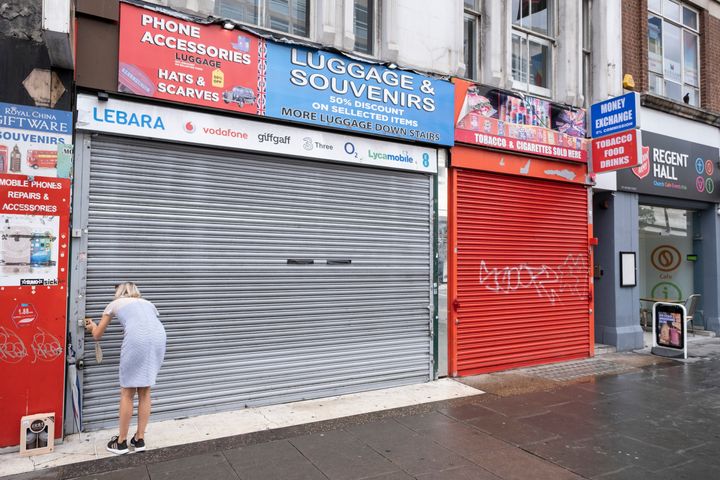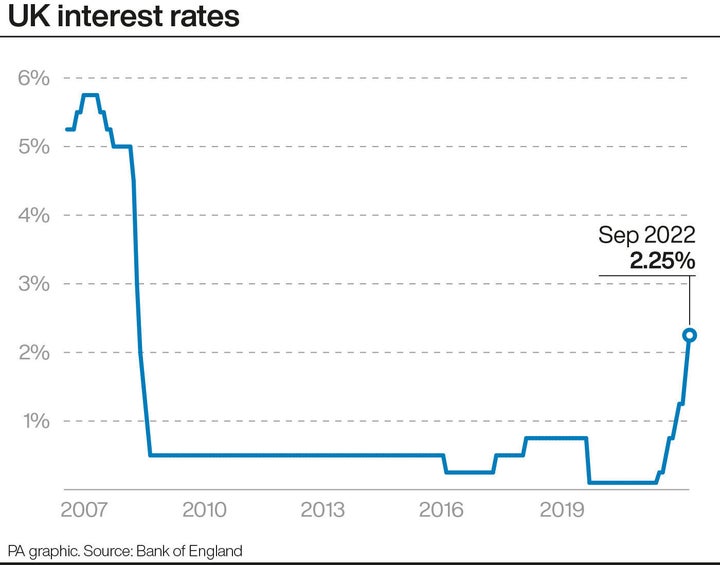
The Bank of England is poised to unveil the biggest hike in interest rates for 33 years next week amid warnings that spending cuts and tax hikes under new prime minister Rishi Sunak could lead to a deeper and more enduring recession.
The central bank’s key Monetary Policy Committee meeting on Thursday is likely to see interest rates go up by 0.75 percentage points to 3%, most economists think.
It will be the eighth consecutive jump in interest rates by the Bank but will represent the biggest increase since 1989.
The decision to lift rates is a bid to keep inflation under control. It is the best tool that the Bank has to steer inflation – currently at 10.1% – back to its 2% target.
A looming recession – a word that sends alarm bells ringing for many – comes as the Ukraine war compounds a crippling cost-of-living crisis as the world comes out of a pandemic.
The financial chaos caused by the mini-budget announced – and subsequently reversed – by former prime minister Liz Truss has also added to the economic gloom.
What is a recession?
A technical recession is defined by two successive quarters of falling economic output – measured by gross domestic product (GDP), which attempts to summarise all the activity of companies, governments and individuals in an economy in a single figure.
The Bank had previously projected the economy would grow in the current financial quarter but said it now believes GDP will fall 0.1%.
It comes after a reported 0.2% fall in GDP in the second quarter and would mean the economy is currently in recession.
Some people argue the term “recession” is an unreliable indicator because people could be suffering all the effects of an economic downturn, such as long-term unemployment, but the data might not be officially say as much.

For instance, a “double-dip recession” is when a recession is followed by a short-lived recovery and another recession, but people’s lives do not feel much different throughout that period.
Recessions ultimately have an impact on living standards, but the full effect largely depends on the scale of unemployment and how long it takes for businesses and the jobs market to recover.
When was the last recession?
Not that long ago.
In 2020, the Office for National Statistics officially declared the UK in recession – the steepest on record – after the economy plunged by 19.6% between April and June due to the coronavirus lockdown.
It followed a 2.2% contraction in the previous three months – marking the first time since the 2008 global financial crisis, when the UK fell into a year-long recession.
But this was followed by growth of 17.4% in the third quarter of 2020 – underlining how the economy was lurching from one extreme to another during the early stages of the pandemic.
What is fuelling a potential recession?
The world is being buffeted by a unique set of circumstances.
Inflation is surging as a result of the easing of the pandemic. It means the costs of goods and services have become more expensive because of a number of factors – such as the scarcity of workers unwilling to do jobs they previously had, and pent-up demand from consumers.
Economists believed this was a big problem as the cost of life’s expenses was growing faster than people’s wages, but that would only be temporary. Then Russia invaded Ukraine, which sent energy prices spiralling given the world’s reliance and oil and gas from the region.
The Bank has said it is also worried about the impact of renewed Covid-19 lockdowns in China which threaten to hit supply chains again and add to inflation pressures.
What is ‘stagflation’?
Economists think the Bank is walking a tightrope to avoid an economic “perfect storm” called stagflation – a contradictory situation where costs are rising but fewer people are in work. The worst of all worlds.
Raising interest rates might help to combat inflation, but that could mean the economy stalls. Using interest rates could be a particularly blunt instrument when the inflationary pressures are coming from overseas with higher energy costs.
The risk is this: more nudges by way of further interest rate hikes could be the catalyst for a full-blown recession. It is tightrope that the monetary policies set by the Bank of England, and the fiscal decisions made by the government, have to navigate.
What is the government doing?
The Bank’s rates decision comes ahead of the autumn budget on November 17, where Sunak and chancellor Jeremy Hunt are likely to unveil up to £50 billion of spending cuts and tax rises to fill a gaping black hole in the nation’s finances.
The prime minister said on Friday he was working through “difficult decisions” with the chancellor, with Sunak focused on bringing down inflation and limiting rises in interest rates.
The UK was already facing grim economic forecasts before the economic plan devised by Truss and her chancellor, Kwasi Kwarteng, crashed the pound and sent mortgage rates soaring, forcing the Bank of England to intervene to calm the markets. Amid the chaos, Labour surged to a 30-point poll lead.

Junking the previous leadership dash for growth via low-tax “trickle-down economics”, the new chancellor has pledged to get “debt falling over the medium term” and has warned of “very, very difficult decisions” being required on tax and spending.
Earlier this month, markets had predicted the interest rate increase could be as much as one percentage point – but sentiment has calmed somewhat after the change of chancellor and prime minister and Bank of England bond purchases pushed down on the cost of borrowing.
However, the savings may be difficult to come across. The Institute for Fiscal Studies has warned that many departments’ spending budgets are still far below their 2010 levels in real terms, in some cases more than 25% lower, making further savings hard to come by.
